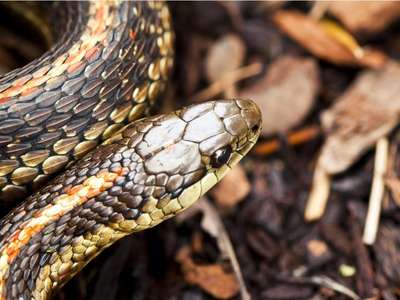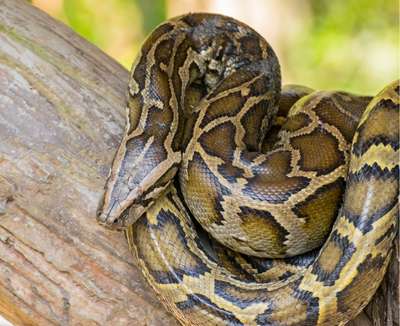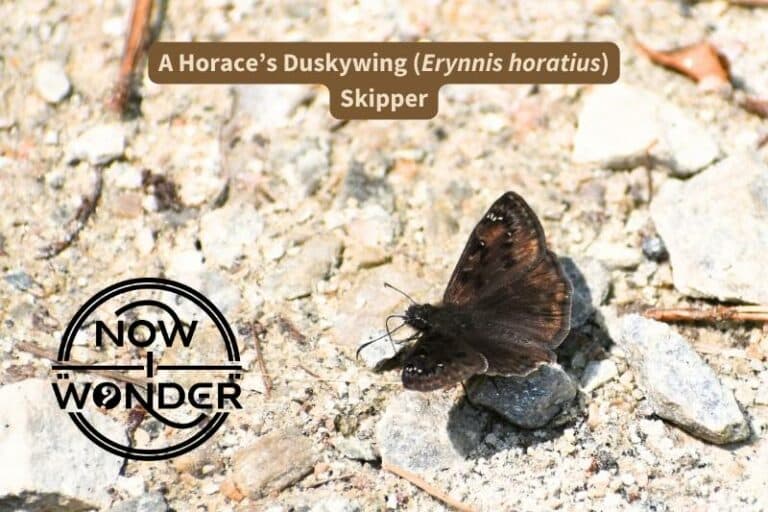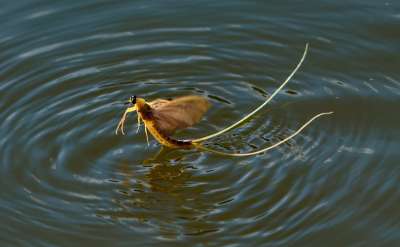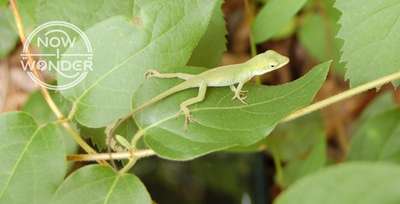The Common Checkered Skipper is a small, energetic butterfly named for the checkered pattern on its wings. The most widely distributed skipper species in North America, it is found throughout North Carolina. Despite wingspans of only 1.5 inches (3.8 cm), adults survive North Carolina winters.

Fun Facts About Common Checkered Skipper Butterflies to Wow Your Friends
- Male Common Checkered Skipper butterflies patrol and defend small territories aggressively.
- They fly out to intercept trespassers and attempt to drive them off their territory.
- Trespassers can be rival Common Checkered Skipper males or any flying insect.
- Common Checkered Skippers are very energetic fliers. They never linger on perches but bound from flower to flower with rapid, darting flight.
- Common Checkered Skipper butterflies are the most common and widespread skipper species in North America (Brock and Kaufman 2006).
- But a very similar skipper species may be taking over. White Checkered Skippers (Pyrgus albescens) have expanded their range into the Deep South. The two skippers look identical. Only their internal anatomy differentiates them (Daniels 2003).
- Another look-alike species is the Tropical Skipper (Pyrgus oileus). The differences between the Tropical and the Common Checkered are minute.
- Both have wings edged with small white spots. Those on Common Checkered butterflies are about the same size. Those on Tropical butterflies vary slightly in size.
- Both have long, blue scales that look like hair on their wings. Tropical Skippers have more of them than Common Checkered Skippers.
- But Tropical Skippers live far to the south, in a narrow band along the Gulf of Mexico. While they do stray into North Carolina from time to time, they are rare in the state.
- In contrast, Common Checkered Skippers are common in North Carolina. They live in every habitat across the entire state.
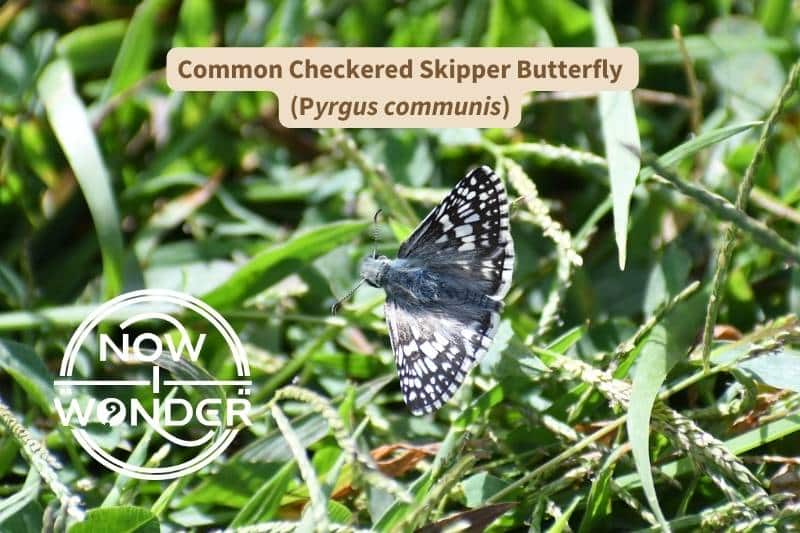
How are Common Checkered Skipper Butterflies Classified?
| Kingdom | Animalia |
| Phylum | Arthropoda |
| Class | Insecta |
| Order | Lepidoptera |
| Family | Hespiriidae (“true skippers”, subfamily Pyrginae (“spreadwing skippers”)) |
| Genus species | Pyrgus communis |
How Do I Know I’m Looking At a Common Checkered Skipper Butterfly?
Appearance of Common Checkered Skipper Butterfly Eggs
Common Checkered Skipper eggs start out pale green. Female Common Checkered Skipper butterflies lay them one a time on the leaves of host plants. As the larvae develop inside, the eggs change color from green to cream (Pyle 1981).
Appearance of Common Checkered Skipper Butterfly Caterpillars / Larvae
Common Checkered Skipper caterpillars are quite small, growing to only about 1.5 inches (3.8 cm). Their bodies can vary in color from green to pale pink but are usually green. A faint, wide gray-green line runs lengthwise down their backs. Numerous tiny white spots speckle their skin. Short, thick bristles cover their bodies and make the caterpillars look fuzzy.
These caterpillars share the head shape characteristic of skipper butterflies. Their heads are large in proportion to their bodies, and look like big, brown balls stuck onto a thin “neck” collar. The bristles that sprout from their neck collars are longer than the body bristles (Wagner 2005), and reinforce the resemblance to a “collar”.
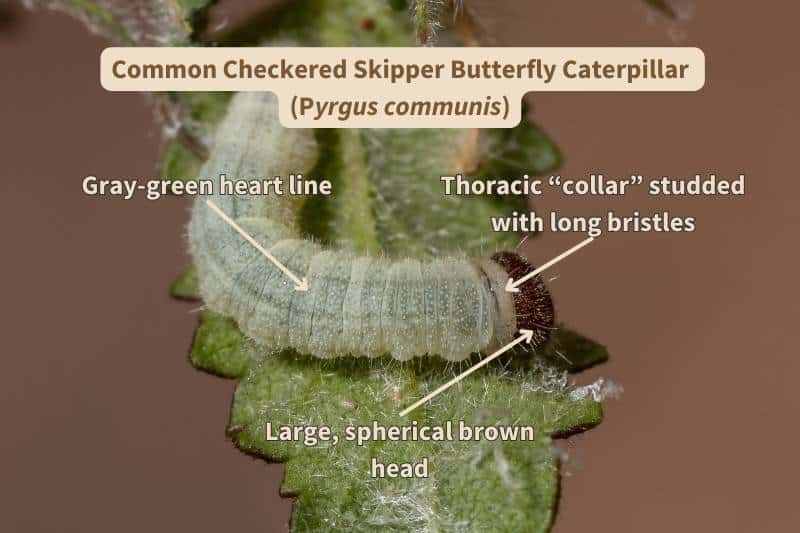
Common Checkered Skipper butterfly chrysalids are two-toned. The head end is green and shades to brown towards the tail end tip. Brown speckles and dashes decorate the chrysalids’ cases (Pyle 1981).
Appearance of Adult Common Checkered Skipper Butterflies
Common Checkered Skipper butterflies are small, dark butterflies, with 0.75 – 1.5 inches (1.9 – 3.8 cm) wing-spans.
Males tend to be more bluish-gray than females, which are darker black. Both have wide heads, large black eyes and black and white striped antennae. Their antennae are hooked at the ends rather than clubbed. This shape characterizes “skipper” butterflies.
Long scales extend across the top surface of Common Checkered Skipper wings. These scales are usually bluish-white on males and brown or tan on females. The scales look like long, soft, fur.
Numerous white squares fill the top of their dark wings. These butterflies look like they’ve been sprinkled with tiny cubes of sea salt. This gives them a checkered appearance, and explains their common name.
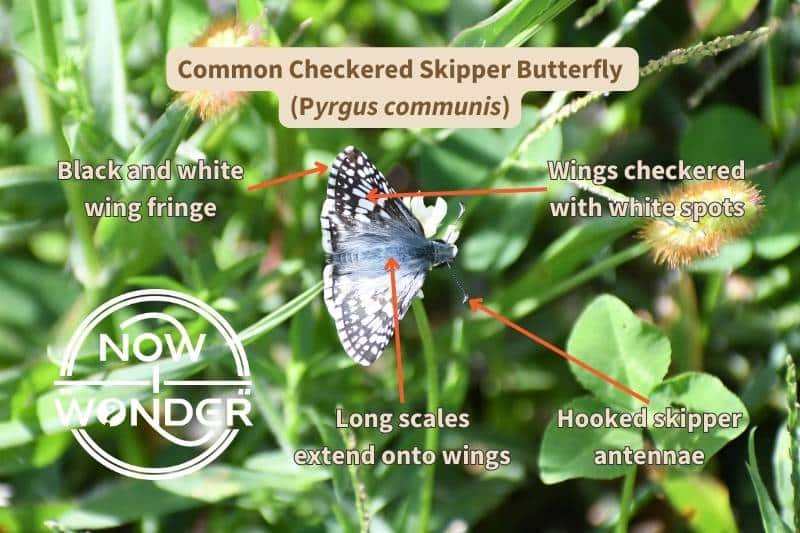
The underside of their wings are much lighter than the upper surface. The wing markings are lightly patterned with dark and light patches. Thin black lines outline the light patches, which form a band across the wings (Pyle 1981).
Thick bands of black and white fringe edge their wings.
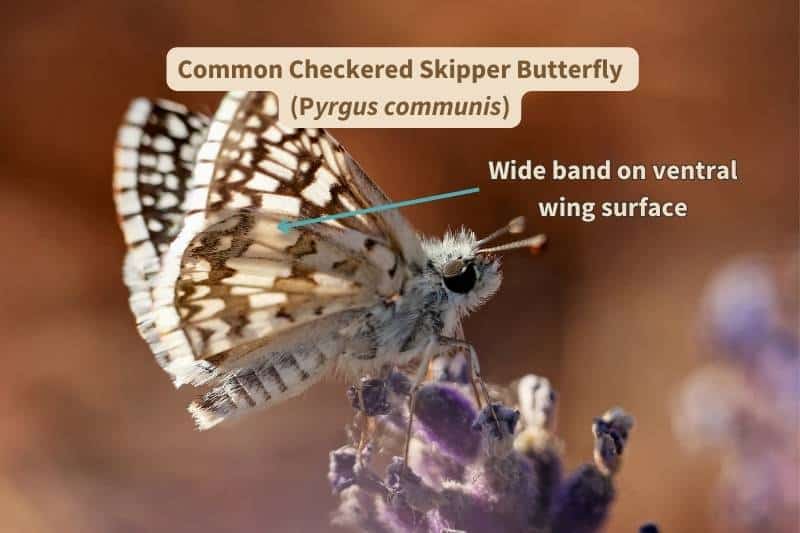
When Can I Find Common Checkered Skipper Butterflies in North Carolina?
In North Carolina, Common Checkered Skipper butterflies fly from early spring through fall. Look for them to emerge starting around mid-April. They have multiple broods every season, so can be found all summer long until mid to late October.
They become more common as the summer progresses. August and September have the most individuals. Adults overwinter in North Carolina (Glassberg 1999).
Where Should I Look to Find Common Checkered Skipper Butterflies in North Carolina?
Common Checkered Skipper butterflies are common throughout the state of North Carolina. They live in every habitat from the coast, through the Piedmont, and even into the mountains.
Look for these butterflies in open, disturbed areas like roadsides, old farm fields, and utility easements. They prefer areas with lots of low vegetation and some bare soil, like around road shoulders and in vacant lots (Opler and Malikul 1992).
Common Checkered Skipper butterflies are very active. They bounce from flower to flower with rapid, darting flight. They rarely land for more than a second or two, so you have to be quick to get a good look. But they do help out by spreading their wings when they do land, so you can see their checkerboard patterns.
On the other hand, Common Checkered Skipper caterpillars are hard to find out in the open. Like many species in the Skipper family, Common Checkered caterpillars hide from predators in leaf shelters. They bend leaves over and anchor the free edges together with silk to form little tents. The caterpillars crawl inside and hunker down to feed and rest.
Their leaf shelters are easier to spot in the wild than the caterpillars themselves. Look inside curled leaves on Rose Mallow (Hibiscus coccineus), Swamp Mallow (Hibiscus moscheutos), and Carolina Mallow (Modiola caroliniana). You may see a Common Checkered Skipper caterpillar happily munching away.
What Do Common Checkered Skipper Butterflies Eat?
Common Checkered Skipper Larval Food Plants
Caterpillars feed on both wild and ornamental plants in the Mallow family (Malvaceae). Mallows are also known as “hibiscus”.
North Carolina plants in this family include:
- Rose Mallow (Hibiscus coccineus)
- Swamp Mallow (Hibiscus moscheutos)
- Carolina Mallow (Modiola caroliniana)
- Hollyhocks (Althaea rosea) – cultivated garden plant
Common Checkered Skipper Adult Butterfly Food Plants
Adult Common Checkered Skipper butterflies sip nectar from a variety of flowers. They especially like plants within the Aster family (Asteraceae).
North Carolina plants in the Aster family include:
- Eastern Daisy Fleabane (Erigeron anuus)
- Ox-eye Daisy (Leucanthemum vulgare)
- Hairy White Oldfield Aster (Symphyotrichum pilosum)
- Greater Tickseed (Coreopsis major)
- Bearded Beggartick (Bidens aristosa)
References
Brock, Jim P., and Kaufman, Ken. 2006. Kaufman Focus Guides: Butterflies of North America. New York: NY. Houghton Mifflin Company.
Daniels, Jaret C. 2003. Butterflies of the Carolinas. Cambridge, MN: Adventure Publications Inc.
Glassberg, Jeffrey. 1999. Butterflies Through Binoculars: The East. New York, NY: Oxford University Press.
Opler, Paul A., and Malikul, Vichai. 1992. Peterson Field Guides: Eastern Butterflies. New York, NY: Houghton Mifflin Company.
Pyle, Robert Michael. 1981. National Audubon Society Field Guide to Butterflies. New York, NY: Alfred A. Knopf.
Wagner, David L. 2005. Princeton Field Guides: Caterpillars of North America. Princeton, NJ: Princeton University Press.

